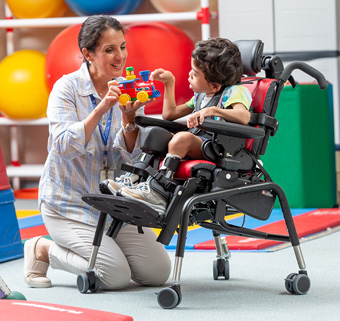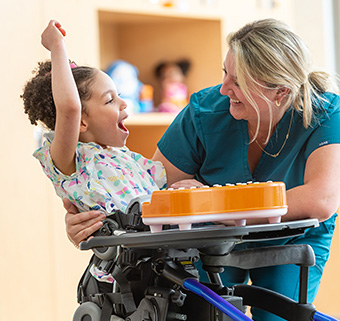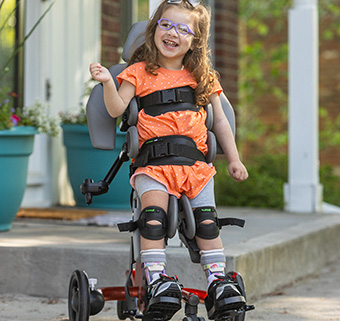Adapted Standing Interventions for Children with Medical Complexity
| February 2024 The first part of our series discussed seating interventions for children with medical complexity. In this article we will focus on standing. Children with medical complexity (CMC) are defined as having high health care needs, one or more chronic conditions, and often require medical technology and significant environmental modifications (Cohen, 2011). Typically children in this category are functioning at Gross Motor Functioning Classification System (GMFCS) level IV or V (CanChild).
The first part of our series discussed seating interventions for children with medical complexity. In this article we will focus on standing. Children with medical complexity (CMC) are defined as having high health care needs, one or more chronic conditions, and often require medical technology and significant environmental modifications (Cohen, 2011). Typically children in this category are functioning at Gross Motor Functioning Classification System (GMFCS) level IV or V (CanChild).
Adaptive Standing for CMC: A Research Review
Standing is thought to have many benefits for children with multiple disabilities including bowel management, bone density, tone management, range of motion, and pain management among others (Damcott, et al., 2013; Capati, et al., 2020). Similar to most other interventions in this population, the research on standing is sometimes mixed. Studies may be small, similar cohort groups are difficult to find, and results are not always consistent, making it difficult to make decisions about standing. However, there have been recent studies which had favorable results in terms of hip abduction and standing. Martinsson and Himmelmann (2021) performed a standing study for children with cerebral palsy (CP) who were GMFCS levels IV and V. They found that the children who stood with 15-30° of hip abduction for ten hours per week had improved range of motion and decreased hip migration percentages compared to those who stood with 0-10° of abduction. This improvement was maintained for seven years in children with or without surgery who stood with abduction. Gmelig Meyling et al. (2018), performed a systematic review of literature on hip migration and postural management in children with CP. They found multiple articles that supported the idea that hip migration percentages were decreased with standing, but they stated that sufficient evidence was lacking in order to make strong recommendations. Han et al. (2017) compared bone density in children who were GMFCS level V and had high tone with children who were typically developing. There were two groups of children in the standing group – those who stood two hours per day for five days per week and those who stood for 20 minutes per day for two to three days per week and had PT. The group that stood for two hours per day had an increased trend towards improved bone mineral density while the group who stood for less time had a trend towards decreased bone mineral density (the change was not significant for either group). In terms of pain and contracture management, Capati et al. (2020) noted improvement in pain management, bowel management, and range of motion in a single 16-year-old subject (GMFCS level V) who completed a standing program for 15 months. What is very interesting about this article is that this subject had a 40° knee flexion contracture on one leg and bilateral hip flexion contractures and had not stood for years. They used a knee and hip contracture system to position him in the stander.
Adaptive Standing Positioning Considerations
When implementing adaptive standing interventions, there are a few things to keep in mind. There is a great infographic on the SeekFreaks website that lists important considerations regarding orthopedic and pulmonary issues. A therapist should also consider the classroom or room size, the height of the peers, and the activities a child will participate in, as well as other impairments such as decreased bone density or cardiopulmonary restrictions. In general, our group tends to avoid prone standers when students are taller or heavier and dependent for transfers, as these standers can make it hard to load and unload students. We also encourage therapists to ask the students and parents for their preferences.
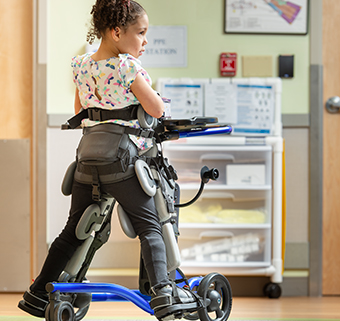
The Rifton Stander
Rifton has multiple options for standing which include their new stander that switches from a supine to a prone stander and has many features for positioning including hip abduction up to 30°, the ability to stand at various angles, as well as individually adjustable legs (great for a leg length discrepancy or range of motion differences). Padded trunk and hip laterals and straps are available to safely secure the student. Its large wheels and steering casters allow for easy mobility so students can participate in standing activities with their peers. A stander like this would be ideal for multiple students or different activities for an individual student. Based on the most recent research from Martinsson and Himmelmann (2021), the use of hip abduction can be helpful in improving range of motion and migration percentage.
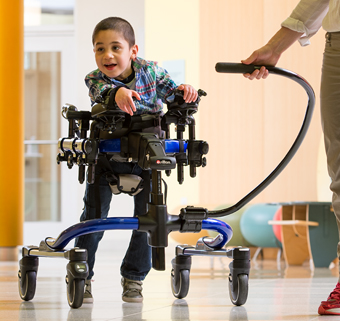
The Rifton Pacer
Because active movement may be more beneficial than static standing (Tornberg et al., 2020), options such as a Rifton Pacer gait trainer or the Rifton TRAM may be beneficial for the students who have some level of mobility. Often students who are GMFCS level IV can walk short distances with an assistive device. At times, you may need static positioning for an activity, and in these cases, it might be beneficial for your student to use the walker with the wheels locked. Of course, an assistant should be next to the student in this case. We have occasionally used a walker in place of a stander for students who are GMFCS level V when insurance or space limited our ability to get a stander. But this option is probably only best for short periods of time and is dependent on the proximity of an assistant.
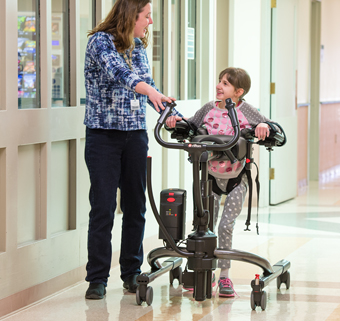
The Rifton TRAM
The TRAM may also be useful for these students. Additionally, some students love movement and have better use of their arms than their legs and for those students, the mobile standers with large wheels may be a good option. These would also offer some cardiopulmonary benefit similar to the Pacer or TRAM.
It is important to offer functional activities while standing, including: participating in cooking activities, balloon volleyball, badminton, PE activities, tag games using technology like a switch to participate with peers, Smart Board or chalkboard activities, craft and art activities, music or choral activities, and modified yoga or aerobic activities to name a few. Again, consider peers: if they are standing your student may also want to stand.
Monitoring for pain and comfort
In order to gauge tolerance to activities and to provide the best recommendations for standing time a variety of pain scales should be used including the Individualized Numeric Rating Scale (INRS) (Solodiuk & Curley, 2003) and the Face, Legs, Activity, Cry, Console Scale (FLACC) (Merkel et al., 1997). A copy of these scales should be kept in the areas where the children/young adults are seen to help staff identify painful behaviors and know when to stop or modify an activity based on these responses. Some children can also use a switch to alert staff to assist them in changing positions. Also watch for color changes in the skin to identify cardiopulmonary fatigue. Using pulse oximeters and blood pressure monitors, especially when you first start standing or change the angle of the stander, is an important way to monitor for cardiopulmonary changes and tolerance. Also, remember to raise and lower students slowly so as not to cause sudden changes in tone, heart rate and blood pressure.
Measuring Standing Tolerance and Creating Appropriate Goals
Children and teens with medical complexity can make very small, but very functional changes measured with SMART (Specific, Measurable, Achievable, Relevant, Time-bound) or GAS (Goal-Attainment Scaling) style goals using adapted equipment. Some of the gains will be in the level of caregiver assistance (i.e. the caregiver may be providing less support or assistance). Some ideas for goals using Rifton adapted standers include:
Sample SMART goals:
- Given full postural supports of supine stander at 75° of tilt, the student will stand for 30 minutes in reading class with peers, without pain behavior as measured by the FLACC, on 75% of observed trials.
- To improve school participation, the student will stand in stander for 60 minutes and participate in music class using an adaptive musical instrument with minimal assistance.
- While in stander for 60 minutes at home, the student will complete a weekly homework assignment with minimal to moderate assistance from family.
- While standing in PE, the student will participate in activities with his peers, given assistance at their upper extremities as needed, for one hour intervals three days per week.
Sample GAS goal:
Given full postural supports of supine stander at 75° of tilt, the student will stand for 60 minutes in enrichment class with peers, without pain behavior as measured by the FLACC.
|
Attainment Level |
Score |
Description |
|
Baseline |
-2 |
Given full postural supports of supine stander at 75° of tilt, the student will stand for 30 minutes in enrichment class with peers, without pain behavior as measured by the FLACC. |
|
Less than expected outcome |
-1 |
45 minutes |
|
Expected outcome |
0 |
60 minutes |
|
Greater than expected outcome |
1 |
75 minutes |
|
Much greater than expected outcome |
2 |
90 minutes |
We hope that this information has been helpful. Our next post will focus on walking and exercise activities to reduce sedentary behaviors for children and adults with medical complexity.
References
- CanChild. Gross Motor Function Classification System- Expanded & Revised (GMFCS- E&R). 2024. Accessed January 4, 2024. https://canchild.ca/en/resources/42-gross-motor-function-classification-system-expanded-revised-gmfcs-e-r
- Capati V, Covert SY, Paleg G. Stander use for an adolescent with cerebral palsy at GMFCS level V with hip and knee contractures. Assistive Technology. 2020;32(6):335-341.
- Cohen E, Kuo DZ, Agrawal R, et al. Children with medical complexity: An emerging population for clinical and research initiatives. Pediatrics. 2011;127(3):529-38. doi: 10.1542/peds.2010-0910.
- Damcott M, Blochlinger S, Foulds R. Effects of passive versus dynamic loading interventions on bone health in children who are nonambulatory. Pediatr Phys Ther. 2013;25(3):248-55. doi: 10.1097/PEP.0b013e318299127d.
- Gmelig Meyling C, Ketelaar M, Kuijper MA, Voorman J, Buizer AI. Effects of Postural Management on Hip Migration in Children With Cerebral Palsy: A Systematic Review. Pediatr Phys Ther. 2018 Apr;30(2):82-91. doi: 10.1097/PEP.0000000000000488.
- Goodwin J, Lecouturier J, Crombie S, et al. Understanding frames: A qualitative study of young people's experiences of using standing frames as part of postural management for cerebral palsy. Child Care Health Dev. 2018;44(2):203-211. doi: 10.1111/cch.12540.
- Han EY, Choi JH, Kim SH, Im SH. The effect of weight bearing on bone mineral density and bone growth in children with cerebral palsy: A randomized controlled preliminary trial. Medicine (Baltimore). 2017;96(10):e5896. doi: 10.1097/MD.0000000000005896.
- Martinsson C, Himmelmann K. Abducted Standing in Children With Cerebral Palsy: Effects on Hip Development After 7 Years. Pediatr Phys Ther. 2021;33(2):101-107. doi: 10.1097/PEP.0000000000000789.
- Merkel SI, Voepel-Lewis T, Shayevitz JR, Malviya S. The FLACC: a behavioral scale for scoring postoperative pain in young children. Pediatr Nurs. 1997;23(3):293-297.
- Seek Freaks-Assistive Tech: Choosing a stander for the classroom and home. Accessed Febuary 2024. https://www.seekfreaks.com/index.php/2018/02/17/resources-choosing-a-stander-for-the-classroom-and-home/
- Solodiuk J, Curley MAQ. Pain assessment in nonverbal children with severe cognitive impairments: The Individualized Numeric Rating Scale (INRS). J Pediatr Nurs. 2003;18(4):295-299.
- Tornberg ÅB, Lauruschkus K. Non-ambulatory children with cerebral palsy: effects of four months of static and dynamic standing exercise on passive range of motion and spasticity in the hip. PeerJ. 2020;8:e8561. doi: 10.7717/peerj.8561.
